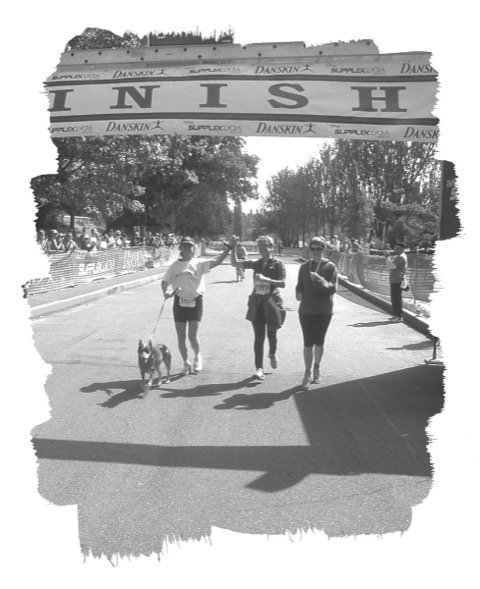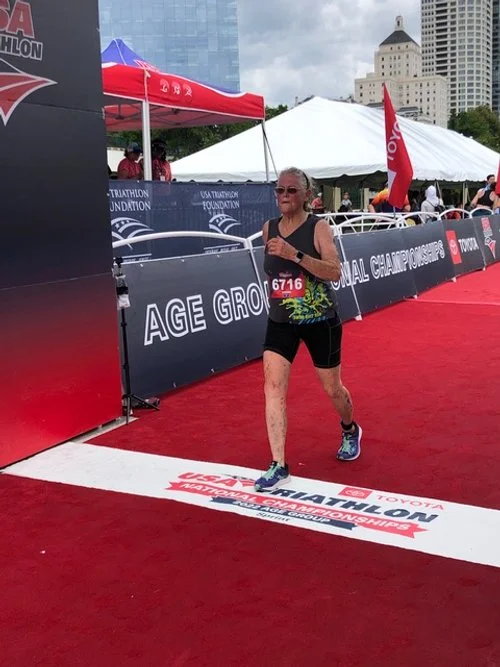Sally “Sal” Edwards
For someone who wholeheartedly espouses the philosophy of leading from behind, Sally “Sal” Edwards is no stranger to being at the front of endurance races and the forefront of revolutions in running retail and exercise physiology. “Leading from the back is antithetical to the American political and business elites’ style of running a business, and running a race,” she observed. But Edwards has not made a name for herself by emulating anyone else’s style.
Growing up as an athletic girl in a pre-Title IX era, Edwards had few opportunities to participate in sports – aside from trying to keep up with her three older brothers. “I always tried to beat them, and I hardly ever could do that,” she said. Not until her collegiate years at UC Berkeley could she fully engage her competitive nature in organized basketball, volleyball, and softball.
Edwards didn’t pick up running until after college, when her then-boyfriend challenged her to a one-mile race. Racing was new to her, and neither she nor he had done any training, but her triumphant victory dawned a life-changing realization. “I kind of like beating the guys,” she recalled thinking at the time. “And still do to this day.”
After racing just one mile against just one person, she was hooked. “I decided I wanted to enter a five-mile race, and then I did a ten-mile race, and I won that and I thought ‘well it looks like I have some running talent, or physiology, or ability.’ And, like most runners, it progressed.” That progression led to her first marathon, which she led until she hit the wall and struggled to finish. Then she figured that if she could race 26.2 miles she could do 50, and if 50 then 75, and if 75 then 100. “I was using my body as the research lab. I kept asking myself, ‘how far and how hard can the human body go?’”
Edwards eventually became a Nike-sponsored runner and competed in a number of marathons, including the inaugural US Olympic Marathon Trials in 1984. While she didn’t consider herself a threat to earn an Olympic bid, she felt compelled to qualify for and run in the race as a celebration of women’s distance running. She ran the first half of the race with the legendary Sister Marion Irvine, buoyed by cheers such as “Sister, I see wings on your feet!”
Her marathons were interspersed with ultramarathons, both of which were ultimately supplanted by triathlons. In 1980 she won the Western States Endurance Run, which is largely considered the most difficult 100-miler in the US. The race wasn’t grueling, she recalled, but “really a beautiful course and tons of fun.” She raced 75 miles around Lake Tahoe, set the women’s record in the 100-mile Iditashoe Snowshoe Race, and completed sixteen Ironman Triathlons, including setting a Masters’ record.
Edwards went on to personify the concept of leading from the back as the final finisher in 125 Danskin Triathlons. If she finished in last place, no other woman would need to fear or worry about doing so. This prompted “women [to] sign up in mass numbers. Because, women, however we instill this psychologically or emotionally into their being, all feel they’re going to finish last. And they won’t enter.”
Racing was fundamental to Edwards’ existence, but it didn’t necessarily pay the bills. After being forced out of a PE teaching job, in 1976 she co-founded Fleet Feet, a running retail store, in an old Victorian home in midtown Sacramento. The company took off, establishing a new model for running retail and further cementing Edwards’ contributions to the running world. By the time she sold the company in 1993, it had 40 locations across the US and $20 million in retail sales. Today, it has over 250 locations and is a hub for runners throughout the country.
Not one to sit around twiddling her thumbs, Edwards – who before selling Fleet Feet had also co-founded a snowshoe company – used the proceeds from the Fleet Feet sale to start another company, Heart Zones, which provides heart-rate-based training and technology to schools, fitness clubs, and individuals as part of her quest to “get America fit.” Edwards earned undergraduate and Master’s degrees in exercise science from UC Berkeley and spent years training and racing with a heart-rate monitor, rendering Heart Zones a fusion of the brains of her education, the brawn of her training, and the heart of her desire to motivate and inspire people to get fit.
Edwards has shared her expertise in training methods and exercise physiology across 24 books and over 500 articles, many of which were ahead of their time. She also served as a research subject in the early-1980s, wearing a heart-rate monitor and electrodes during workouts so her data could be analyzed. Regarding her entrepreneurial and exercise physiology breakthroughs, she remarked, “I notoriously have been about twenty years ahead of different trends.” As one of the first women to complete Western States and the fifth to complete an Ironman, she was similarly ahead of her time in ultra-endurance events.
Edwards is approaching 30 years as CEO of Heart Zones, and at age 75 her entrepreneurial and competitive drives are as strong as ever. After taking over twenty years off from racing, she recently returned to competitive triathlon with the goal of competing in the 2023 World Triathlon Sprint & Relay Championships in Hamburg, Germany.
“When you have a dream, and train to accomplish that…there’s this feeling of joy and accomplishment and self-worth – you can’t get it any other way.”
Sarah Franklin is a writer, runner, and mother living outside of Boston. Her running-related musings take shape @the_runtrovert on Instagram.




